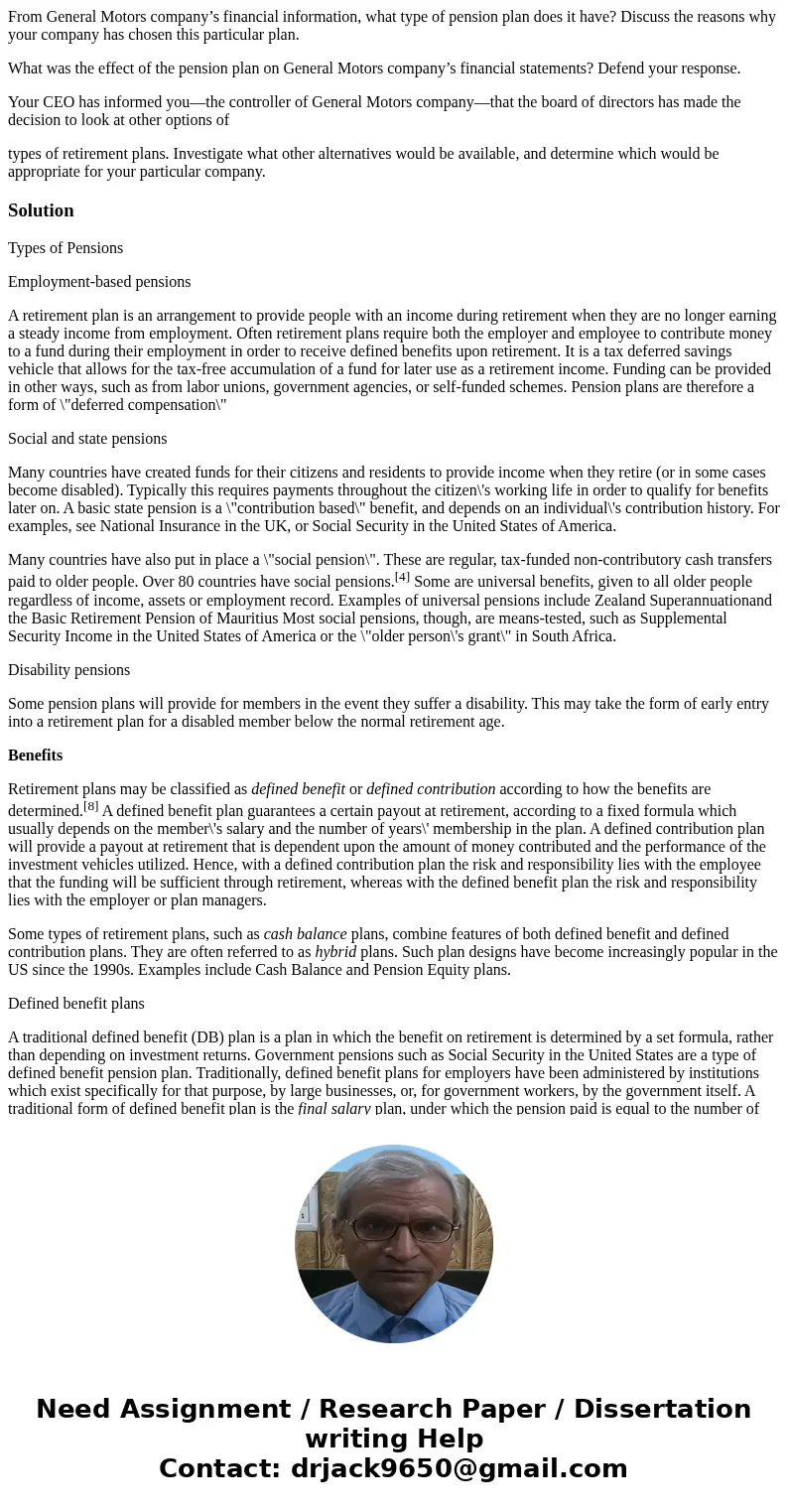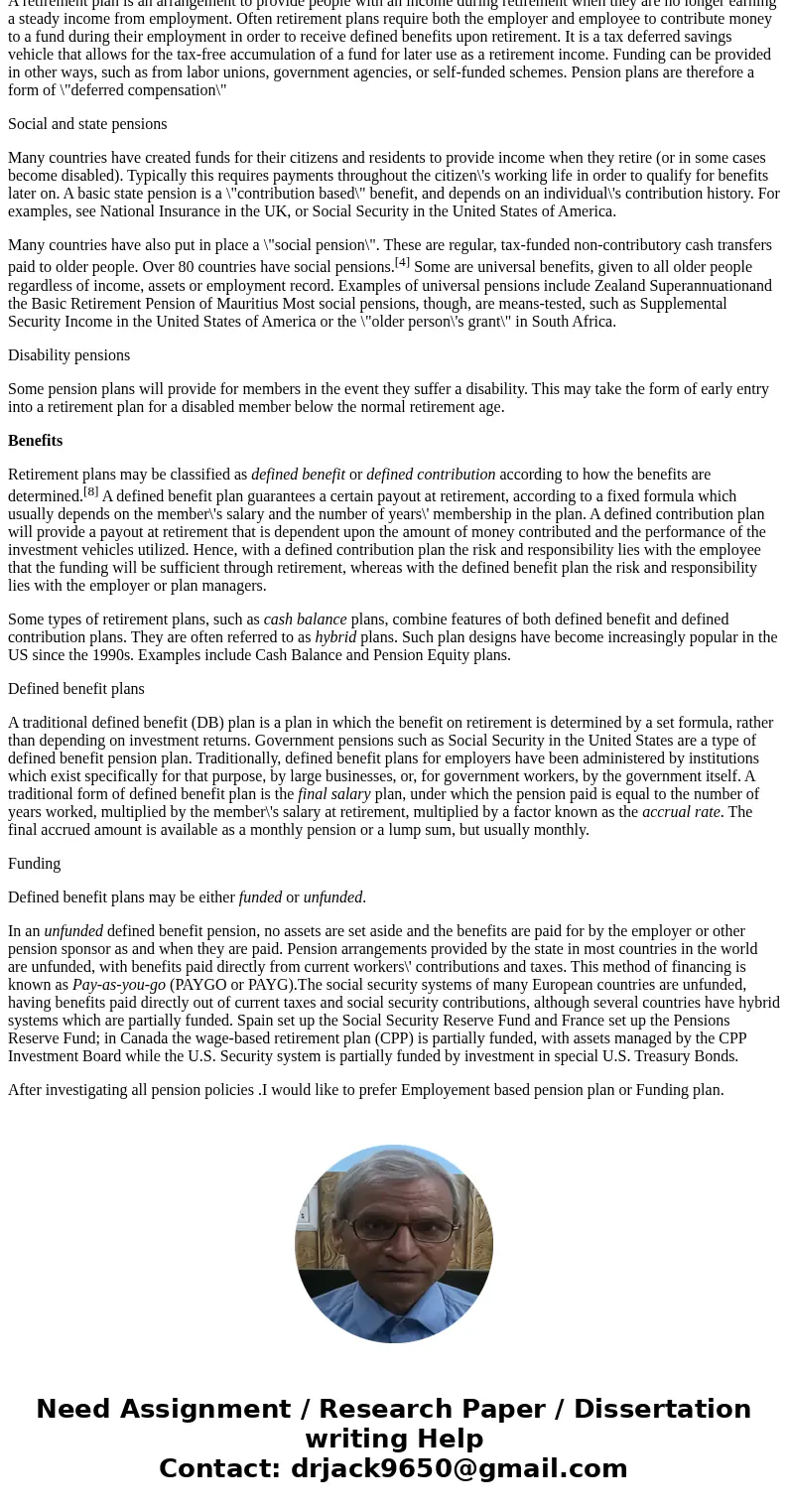From General Motors companys financial information what type
From General Motors company’s financial information, what type of pension plan does it have? Discuss the reasons why your company has chosen this particular plan.
What was the effect of the pension plan on General Motors company’s financial statements? Defend your response.
Your CEO has informed you—the controller of General Motors company—that the board of directors has made the decision to look at other options of
types of retirement plans. Investigate what other alternatives would be available, and determine which would be appropriate for your particular company.
Solution
Types of Pensions
Employment-based pensions
A retirement plan is an arrangement to provide people with an income during retirement when they are no longer earning a steady income from employment. Often retirement plans require both the employer and employee to contribute money to a fund during their employment in order to receive defined benefits upon retirement. It is a tax deferred savings vehicle that allows for the tax-free accumulation of a fund for later use as a retirement income. Funding can be provided in other ways, such as from labor unions, government agencies, or self-funded schemes. Pension plans are therefore a form of \"deferred compensation\"
Social and state pensions
Many countries have created funds for their citizens and residents to provide income when they retire (or in some cases become disabled). Typically this requires payments throughout the citizen\'s working life in order to qualify for benefits later on. A basic state pension is a \"contribution based\" benefit, and depends on an individual\'s contribution history. For examples, see National Insurance in the UK, or Social Security in the United States of America.
Many countries have also put in place a \"social pension\". These are regular, tax-funded non-contributory cash transfers paid to older people. Over 80 countries have social pensions.[4] Some are universal benefits, given to all older people regardless of income, assets or employment record. Examples of universal pensions include Zealand Superannuationand the Basic Retirement Pension of Mauritius Most social pensions, though, are means-tested, such as Supplemental Security Income in the United States of America or the \"older person\'s grant\" in South Africa.
Disability pensions
Some pension plans will provide for members in the event they suffer a disability. This may take the form of early entry into a retirement plan for a disabled member below the normal retirement age.
Benefits
Retirement plans may be classified as defined benefit or defined contribution according to how the benefits are determined.[8] A defined benefit plan guarantees a certain payout at retirement, according to a fixed formula which usually depends on the member\'s salary and the number of years\' membership in the plan. A defined contribution plan will provide a payout at retirement that is dependent upon the amount of money contributed and the performance of the investment vehicles utilized. Hence, with a defined contribution plan the risk and responsibility lies with the employee that the funding will be sufficient through retirement, whereas with the defined benefit plan the risk and responsibility lies with the employer or plan managers.
Some types of retirement plans, such as cash balance plans, combine features of both defined benefit and defined contribution plans. They are often referred to as hybrid plans. Such plan designs have become increasingly popular in the US since the 1990s. Examples include Cash Balance and Pension Equity plans.
Defined benefit plans
A traditional defined benefit (DB) plan is a plan in which the benefit on retirement is determined by a set formula, rather than depending on investment returns. Government pensions such as Social Security in the United States are a type of defined benefit pension plan. Traditionally, defined benefit plans for employers have been administered by institutions which exist specifically for that purpose, by large businesses, or, for government workers, by the government itself. A traditional form of defined benefit plan is the final salary plan, under which the pension paid is equal to the number of years worked, multiplied by the member\'s salary at retirement, multiplied by a factor known as the accrual rate. The final accrued amount is available as a monthly pension or a lump sum, but usually monthly.
Funding
Defined benefit plans may be either funded or unfunded.
In an unfunded defined benefit pension, no assets are set aside and the benefits are paid for by the employer or other pension sponsor as and when they are paid. Pension arrangements provided by the state in most countries in the world are unfunded, with benefits paid directly from current workers\' contributions and taxes. This method of financing is known as Pay-as-you-go (PAYGO or PAYG).The social security systems of many European countries are unfunded, having benefits paid directly out of current taxes and social security contributions, although several countries have hybrid systems which are partially funded. Spain set up the Social Security Reserve Fund and France set up the Pensions Reserve Fund; in Canada the wage-based retirement plan (CPP) is partially funded, with assets managed by the CPP Investment Board while the U.S. Security system is partially funded by investment in special U.S. Treasury Bonds.
After investigating all pension policies .I would like to prefer Employement based pension plan or Funding plan.


 Homework Sourse
Homework Sourse